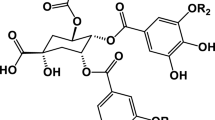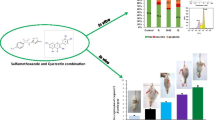Abstract
One of the most clinically relevant biological activities of curcumin is its anti-cancer property, implicating multiple intracellular pathways in the process. In the present report, we investigated the effect of curcumin on the activation of apoptotic and anti-angiogenic pathways in Ehrlich Ascites Tumor (EAT) cells. Treatment with curcumin in vivo resulted in inhibition of proliferation of EAT cells and ascites formation. Further, we demonstrate that the induction of apoptosis in EAT cells showed nuclear condensation, DNA fragmentation and translocation of caspase-activated DNase (CAD) to nucleus upon curcumin treatment. Curcumin-induced apoptosis is mediated through activation of caspase-3, which is specifically inhibited by the caspase-3 inhibitor, Ac-DEVD-CHO. On the other hand, the decreased secretion of ascites by EAT cells is corroborated by reduction in VEGF secretion upon curcumin treatment. Further, CD31 immunohistological staining of peritoneum sections in curcumin-treated mice suggests its efficacy in acting as anti-angiogenic compound in EAT cells by inhibiting proliferation of endothelial cells in mouse peritoneum. However, immunoflurescence studies of NF-kB revealed that the inhibition of nuclear translocation of NF-kB p65, a transcription factor required for VEGF gene expression, in curcumin-treated EAT cells. These results suggest a further possible clinical application of this diet-derived compound curcumin, as both proapoptotic and anti-angiogenic compound in association with conventional chemotherapeutic agents.
Similar content being viewed by others
Abbreviations
- VEGF:
-
vascular endothelial cell growth factor
- CAD:
-
caspase activated DNase
- NF-kB:
-
Nuclear Factor kB
References
Folkman J: Angiogenesis in cancer, vascular, rheumatoid and other diseases. Nat Med 1: 27–31, 1995
Hanahan D, Folkman J: Patterns and emerging mechanisms of the angiogenic switch during tumorigenesis. Cell 86: 353–364, 1996
Brem S: Angiogenesis and cancer control: From concept to therapeutic trials. Cancer Control 6: 436–458, 1999
Boehm T, Folkman J, Browder T, O’ Reilly MS: Antiangiogenic therapy of experimental cancer does not induce acquired drug resistance. Nature 390: 404–407, 1997
Pluda JM: Tumor-associated angiogenesis: Mechanisms, clinical implications, and therapeutic strategies. Semin Oncol 24: 203–218, 1997
Rak J, Kerbel RS: Treating cancer by inhibiting angiogenesis: New hopes and potential pitfalls. Cancer Metastasis Rev 15: 231–236, 1996
Taraboletti G, Margosio B: Antiangiogenic and antivascular therapy for cancer. Curr Opin Pharmacol 1: 378–384, 2001
Cao Y: Endogenous angiogenesis inhibitors and their therapeutic implications. Int J Biochem Cell Biol 33: 357–369, 2001
Min JK, Han KY, Kim EC, Kim YM, Lee SW, Kim OH, Kim KW, Gho YS, Kwon YG: Capsaicin inhibits in vitro and in vivo angiogenesis. Cancer Res 64: 644–651, 2004
You YJ, Nam NH, Kim Y, Bae KH, Ahn BZ: Antiangiogenic activity of lupeol from Bombax ceiba. Phytother Res 17: 341–344, 2003
Chow LM, Chui CH, Tang JC, Lau FY, Yau MY, Cheng GY, Wong RS, Lai PB, Leung TW, Teo IT, Cheung F, Guo D, Chan AS: Antiangiogenic potential of Gleditsia sinensis fruit extract. Int J Mol Med 12: 269–273, 2003
Sharma RA, McLelland HR, Hill KA, Ireson CR, Euden SA, Manson MM, Pirmohamed M, Marnett LJ, Gescher AJ, Steward WP: Pharmacodynamic and pharmacokinetic study of oral Curcuma extract in patients with colorectal cancer. Clin Cancer Res 7: 1894–1900, 2001
Stoner GD, Mukhtar H: Polyphenols as cancer chemopreventive agents. J Cell Biochem 22: 169–180, 1995
Nandkarni KM: Curcuma longa, Popular Prakashan, Bombay, 1976.
Govindaraja VS: Turmeric: Chemistry, technology, and quality. Crit Rev Food Sci Nutr 12: 199, 1980
Ammon HP, Wahl MA: Pharmacology of Curcuma longa. Planta Medica 57: 1–7, 1991
Huang MT, Want ZY, Georgiadis CA, Laskin JD, Conney AH: Inhibitory effects of curcumin on tumor initiation by benzo[a]pyrene and 7,12-dimethylbenz[a] anthracene. Carcinogenesis 13: 2183–2186, 1992
Azuine MA, Bhide SV: Chemopreventive effect of turmeric against stomach and skin tumors induced by chemical carcinogens in Swiss mice. Nutr Cancer 17: 77–83, 1992
Nagbhusan M, Bhide SV: Curcumin as an inhibitor of cancer. J Am Coll Nutr 11: 192–198, 1992
Huang MT, Smart RC, Wong C-Q, Conney AH: Inhibitory effect of curcumin, chlorogenic acid, caffeic acid, and ferulic acid on tumor promotion in mouse skin by 12-O-tetradecanoylphorbol-13-acetate. Cancer Res 48: 5941–5946, 1988
Conney AH, Lysz T, Ferraro T, Abidi TF, Manchand PS, Laskin JD, Huang MT: Inhibitory effect of curcumin and some related dietary compounds on tumor promotion and arachidonic acid metabolism in mouse skin. Adv Enzyme Regulation 31: 385–396, 1991
Kawamori T, Lubet R, Steele VE, Kelloff GJ, Kaskey RB, Rao CV, Reddy BS: Chemopreventive effect of curcumin, a naturally occurring anti-inflammatory agent, during the promotion/progression stages of colon cancer. Cancer Res 59: 597–601, 1999
Liu JY, Lin SJ, Lin SK: Inhibitory effects of curcumin on protein kinase C activity induced by 12-O-tetradecanoyl-phorbol-13-acetate in NIH 3T3 cells. Carcinogenesis 14: 857–861, 1993
Pal S, Choudhuri T, Chattopadhyay S, Bhattacharya A, Datta G, Das T, Sa G: Mechanisms of curcumin-induced apoptosis of Ehrlich’s ascites carcinoma cells. Biochem Biophys Res Commun 288: 658–665, 2001
Jee SH, Shen SC, Tseng CR, Chiu HC, Kuo ML: Curcumin induces a p53-dependent apoptosis in human basal cell carcinoma cells. J Invest Dermatol 111: 656–661, 1998
Pan M, Lin-Shiau S, Lin J: Comparative studies on the suppression of nitric oxide synthase by curcumin and its hydrogenated metabolites through down-regulation of IkappaB kinase and NFkappaB activation in macrophages. Biochem Pharmacol 60: 1665–1676, 2000
Korutla L, Kumar R: Inhibitory effect of curcumin on epidermal growth factor receptor kinase activity in A431 cells. Biochim Biophys Acta 1224: 597–600, 1994
Singh S, Aggarwal BB: Activation of transcription factor NF-kappa B is suppressed by curcumin (diferuloylmethane). J Biol Chem 270: 24995–25000, 1995
Jiang MC, Yang-Yen HF, Lin JK, Yen JJ: Differential regulation of p53, c-Myc, Bcl-2 and Bax protein expression during apoptosis induced by widely divergent stimuli in human hepatoblastoma cells. Oncogene 13: 609–616, 1996
Alfranca A, Gutierrez MD, Vara A, Aragones J, Vidal F, Landazuri MO: c-Jun and hypoxia-inducible factor 1 functionally cooperate in hypoxia-induced gene transcription. Mol Cell Biol 22: 12–22, 2002
Shibata A, Nagaya T, Imai T, Funahashi H, Nakao A, Seo H: Inhibition of NF-kappa B activity decreases the VEGF mRNA expression in MDA-MB-231 breast cancer cells. Breast Cancer Res Treat 73: 237–243, 2002
Thaloor D, Singh AK, Sidhu GS, Prasad PV, Kleinman HK, Maheswari RK: Inhibition of angiogenic differentiation of human umbilical vein endothelial cells by curcumin. Cell Growth Differ 9: 305–312, 1998
Mohan R, Sivak J, Ashton P, Russo LA, Pham BQ, Kasahara N, Raizman MB, Fini ME: Curcuminoids inhibit the angiogenic response stimulated by fibroblast growth factor-2, including expression of matrix metalloproteinase gelatinase B. J Biol Chem 275: 10405–10412, 2000
Shim JS, Kim JH, Cho HY, Yum YN, Kim SH, Park HJ, Shim BS, Choi SH, Kwon HJ: Irreversible inhibition of CD13/aminopeptidase N by the antiangiogenic agent curcumin. Chem Biol 8: 695–704, 2003
Shao ZM, Shen ZZ, Liu CH, Sartippour MR, Go VL, Heber D, Nguyen M: Curcumin exerts multiple suppressive effects on human breast carcinoma cells. Int J Cancer 98: 234–240, 2002
Arbiser JL, Klauber N, van Rohan R, Leeuwen R, Huang MT, Fisher C, Flynn E, Byers HR: Curcumin is an in vivo inhibitor of angiogenesis. Mol Med 4: 376–383, 1998
Gururaj AE, Belakavadi M, Venkatesh DA, Marme D, Salimath BP: Molecular mechanisms of anti-angiogenic effect of curcumin. Biochem Biophys Res Commun 297: 934–942, 2002
Srinivas G, John Anto R, Srinivas P, Vidhyalakshmi S, Priya Senan V, Karunagaran D: Emodin induces apoptosis of human cervical cancer cells through poly (ADP-ribose) polymerase cleavage and activation of caspase-9. Euro J Pharmacol 473: 117–125, 2003
Keifer JA, Guttridge DC, Ashbumer BP, Baldwin AS Jr.: Inhibition of NF-kappa B activity by thalidomide through suppression of I kappa B kinase activity. J Biol Chem 276: 22382–22387, 2001
Kapahi P, Takahashi T, Natoli G, Adams SR, Chen Y, Tsien RY, Karin M: Inhibition of NF-kappa B activation by arsenite through reaction with a critical cysteine in the activation loop of I kappa B kinase. J Bid Chem 275: 36062–36066, 2000
Surh YJ, Han SS, Keum YS, Seo HJ, Lee SS: Inhibitory effects of curcumin and capsaicin on phorbol ester-induced activation of eukaryotic transcription factors, NF-kappa B and AP-1. Biofactors 12: 107–112, 2000
Huang MT, Lou YR, Ma M, Newmark HL, Reuhl KR, Conney AR: Inhibitory effects of dietary curcumin on fore stomach, duodenal, and colon carcinogenesis in mice. Cancer Res 54: 5841–5847, 1994
Rao CV, Rivenson A, Simi B, Reddy BS: Chemoprevention of colon carcinogenesis by dietary curcumin, a naturally occurring plant phenolic compound. Cancer Res 55: 259–266, 1995
Jiang M-C, Yang-Yen HF, Yen JJ, Lin JK: Curcumin induces apoptosis in immortalized NIH 3T3 and malignant cancer cell lines. Nutr Cancer 26: 111–120, 1996
Eamshaw WC, Martins LM, Kaufmann SH: Mammalian caspases: Structure, activation, substrates, and functions during apoptosis. Annu Rev Biochem 68: 383–424, 1999
Thornberry N, Lazebnik Y: Caspases: Enemies within. Science 281: 1312–1316, 1998
Widlak P: The DFF40/CAD endonuclease and its role in apoptosis. Acta Biochim Pol 47: 1037–1044, 2000
Weidner N, Carroll PR, Flax J, Bluementhal W, Folkman J: Tumor angiogenesis correlates with metastasis in invasive prostate cancer. Am J Pathol 143: 401–409, 1993
Shibuya M: Role of VEGF-FLT receptor system in normal and tumor angiogenesis. Adv Cancer Res 67: 281–316, 1995
Thaloor D, Singh AK, Sidhu GS, Prasad PV, Kleinman H, Maheswari RK: Inhibition of angiogenic differentiation of human umbilical vein endothelial cells by curcumin. Cell Growth Differ 9: 305–312, 1998
Perkins ND: The Rel/NF/kB family: Friend and Foe. Trends Biochem Sci 25: 434–440, 2000
Baldwin AS, Jr.: The NF-kB and IkB proteins: New discoveries and insights. Annu Rev Immunol 14: 649–683, 1996
Verma IM, Stevenson J: IkB kinase: Beginning not the end. Proc Natl Acad Sci USA, 94: 11758–11760, 1997
Gutteridge DC, Albanese C, Reuther JY, Pestell RG, Baldwin AS, Jr.: NF-kB controls cell growth and differentiation through transcriptional regulation of cyclin Dl. Mol Cell Biol 19: 5785–5799, 1999
Author information
Authors and Affiliations
Corresponding author
Rights and permissions
About this article
Cite this article
Belakavadi, M., Salimath, B.P. Mechanism of inhibition of ascites tumor growth in mice by curcumin is mediated by NF-kB and caspase activated DNase. Mol Cell Biochem 273, 57–67 (2005). https://doi.org/10.1007/s11010-005-7717-2
Received:
Accepted:
Issue Date:
DOI: https://doi.org/10.1007/s11010-005-7717-2




